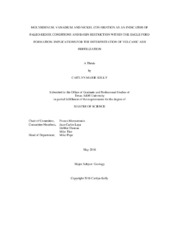| dc.description.abstract | Trace metal analyses of organic carbon rich sediments yields an understanding of the paleoredox conditions at the time of deposition. The specific behaviors of V and Mo differ within strongly reducing versus weakly reducing conditions, allowing additional further classification of the redox conditions by including Ni as a proxy for organic matter flux.
Principal component analyses of V, Mo, and Ni yield four specific zones within the Eagle Ford core where the covariation of the trace metals is distinct. Redox zone I is interpreted as generally oxygenated, and dominates the upper Eagle Ford. Redox zone II is characterized as anoxic, and dominates the middle Eagle Ford. Redox zone III and IV are both characterized as euxinic, however, redox zone IV is hydrographically more restricted than redox zone III, reducing the enrichment of V and Mo. The transition from redox zone IV within the lower portion of the lower Eagle Ford through redox zone I within the upper Eagle Ford suggests an evolving basin morphology through time. As the sediments filled in the restricted accommodation space provided by the pre-existing basin morphology, circulation improved, allowing the redox potential of the water column to drive trace metal enrichment rather than hydrographic effects.
Interpretation of the effect of volcanic ash input to the water column on primary productivity was constrained by an understanding of the principal drivers of trace metal enrichment in the different redox zones of the Eagle Ford. Stark Ni enrichment within many of the ash beds located within redox zones II and III show a similarly large Mo enrichment. This relationship indicates that the input of volcanic ash to the water column enhanced primary productivity (spike in Ni), inducing strongly reducing, euxinic conditions (spike in Mo) compared to the surrounding areas. Stark Ni enrichment within redox zone IV ash beds do not show the same magnitude of Mo enrichment, likely as a result of the hydrographic factors controlling Mo enrichment, which reduces the amount of Mo that can be deposited. | en |


